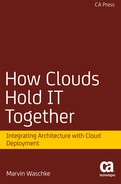Introduction
Cloud computing is changing the computing industry and our daily lives. Without clouds, the search engines like Google that have become an ever-present source of information on every subject would not be possible. There would be no social networking sites like Facebook. Online shopping sites like Amazon would be cramped in scope and unpredictable in performance. Scientific projects like the Human Genome Project would be much more difficult. Businesses are moving more of their IT to cloud implementations every day.
Centralizing data into a cloud that is accessible to mobile devices such as laptops, tablets, and smartphones, as well as desktops on the enterprise premises, has proven successful and has aided in expanding the boundaries of the workplace far beyond the walls of the enterprise office. The nature of the workplace and work styles have changed and forced enterprise governance to change also.
The basics of enterprise software design apply to all enterprise software, but cloud implementations bring new requirements and challenges.
Greater participation in planning by business management is one requirement. Clouds supplied by a cloud service provider rather than owned by the enterprise have distinct advantages, but the presence of a third party complicates the relationship between the enterprise and its IT systems. The involvement of a cloud provider can raise questions about governance, security, and auditability that require the participation of business management. Business factors such as costing methods and accounting for ownership are also likely to change.
Technical solutions may help, but they cannot resolve these business issues. Consequently, cloud projects require intense cooperation between business managers and technologists that similar projects confined to the enterprise premises do not require.
Cloud implementations also require new technical skills that stem from the greater role of network communications and the use of a virtual environment. These issues can be especially challenging when implementing enterprise integration. On the other hand, clouds also present important opportunities for rationalizing and increasing enterprise integration, and the central nature of cloud implementations simplifies and increases the opportunities for integration. On the other hand, the rise of mobile devices and wider geographic distribution of enterprises bring on new technical challenges.
Cloud implementations can be central to reducing the investment in enterprise computing while increasing its functionality and reach. It can also be the key to enterprise integration, but to fully realize the potential, enterprises must undertake cloud computing projects as both business and technical efforts. These projects require a planning, development, and operations methodology that brings these aspects together systematically. The IT Infrastructure Library (ITIL) is a proven set of practices for bringing together business management and technical expertise for the development and management of successful IT services. This book brings cloud computing and service management together with detailed recommendations for successful services built on cloud technology.
